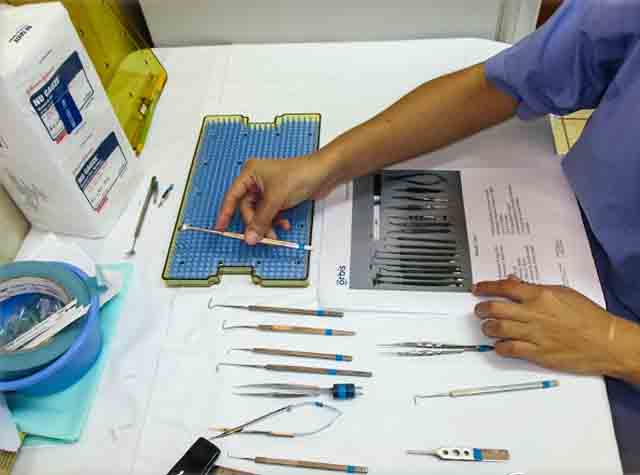Assisting during microsurgery: important first steps

Related content
Scrub nurses or technicians can prepare for their role by learning about instruments and instrument trays, learning the steps of procedures, and reviewing surgical procedures with the surgeons they will assist.
When it comes to assisting during microsurgery, there is much you can learn and practise before you enter the operating theatre.
1. Learn about surgical instruments and trays
The first step in learning to assist during microsurgery is to learn the names of the instruments and to become familiar with the different types of instrument trays.
A good place to start is in the sterilisation area, where instruments are reprocessed and packed for sterilisation in preparation for surgery. While you are in the sterilisation area:
• Use an ophthalmic instrument catalogue to identify the different instruments
• Use a magnifying glass to look at the fine tips of hooks or lens manipulators.
Each type of surgery or ophthalmic subspecialty (e.g. cataract, squint, cornea, oculoplastic) has a different instrument tray, containing the instruments the surgeon will need. Instruments on each of these trays are categorised into:
• Forceps and clamps (forceps can be toothed, smooth, serrated, or micro-notched; straight, curved, or angled)
• Scissors (sharp or blunt tips; straight, curved, or angled)
• Needle holders (locking or non-locking; straight or curved)
• Hooks, lens manipulators, retractors, and loops
• Cannulated instruments, e.g., Simcoe and anterior chamber cannulas
• Blade handles
• Speculums, calipers, or rulers.
Ask a senior colleague to show you what each instrument tray should look like. Take a photograph or draw the tray, then label each instrument. Ask your colleague to check everything is correct and in place.
2. Learn the steps of procedures
An excellent and safe way of preparing for a procedure is to learn the surgical steps and practise for them through simulation.


Watch a video recording of the operation to be performed, or observe a live operation (Figure 2). Write down each surgical step and the instruments and supplies used. You can make a checklist, in table form (see Table 1). Next, arrange the surgical instruments on a simulated/mock ‘sterile field’ in the same order as the surgical steps (Figure 3). If you have a smartphone, take a photo of the setup to remind yourself of the sequence of steps.
3. Review procedures with the surgeon
A scrub nurse or technician may work with a different surgeon every day. It is helpful to set aside time to review the basic steps of the next day’s surgical procedures with the surgeon, as this will help you to anticipate their needs more effectively.
I found it helpful to create a checklist, in table form, for the most common operations I’m likely to be involved in (Table 1), listing the surgical step, the type of consumable the surgeon may use, and the type of surgical instrument the surgeon may use.
Reviewing these steps with the surgeon may feel daunting at first, but you will become more confident the more you do it. When surgeons see that you are interested in being prepared, they will usually be happy to share this information, as it supports collaboration between surgeon and nurse, which can lead to better outcomes for patients.

